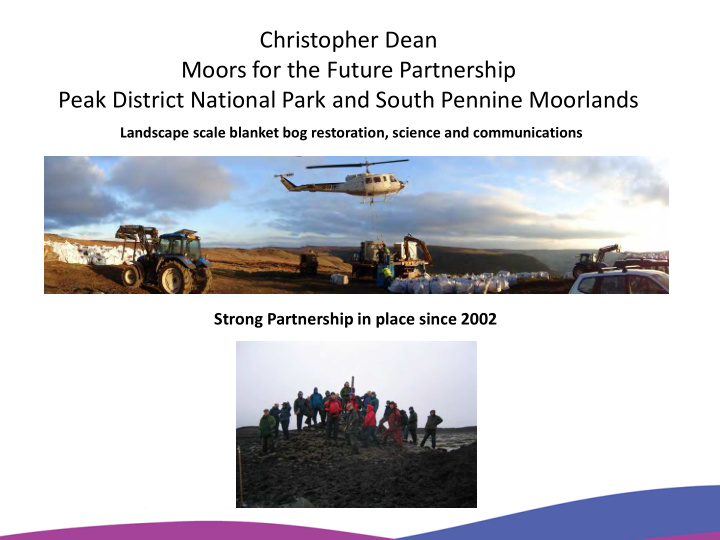



Christopher Dean Moors for the Future Partnership Peak District National Park and South Pennine Moorlands Landscape scale blanket bog restoration, science and communications Strong Partnership in place since 2002
Blanket Bog Gallego-Sala & Prentice (2013) Nature Climate Change
UK Blanket Bog • “ombrotrophic” - water and mineral supply entirely from rainwater, mist, cloud-cover. • nutrient-poor and acidic dominated by acid-loving plants, especially Sphagnum . • UK 10–15 % global resource • South Pennines represents most south-easterly occurrence in Europe.
South Pennine Moorlands •Easily accessible to much of England’s population •Probably most visited moorlands worldwide with tradition of public access •Transition between lowland and highland zones •European and National recognition and protection • High community interest
Threats past and present • Pollution: concentrations of lead in excess of 1000mg kg-1 (for peatland some of the highest globally, Rothwell et al 2005). • Wildfire: 400 serious fires since 1973 • Climate change
Impact of climate change on UK blanket bog Projected changes in bioclimatic space associated with the 1961–1990 baseline climate and mapped area of blanket peat using UKCIP02 high emissions scenarios.
Industrial past and summer wild fires have left an environmental catastrophe Bare and degraded landscape In 2005 nearly 14.5 km2 of bare peat just in the PDNP (Chapman et al 2010) Extremely Acidic ph 2.8 – 3.5 No seed bank high heavy metal content
Restoring severely damaged Blanket Bog
1976 2003 The same family 27 yrs. later with a metre of the surface gone 2008 2010
Sphagnum Reintroduction Project • Baseline survey has showed the main factor limiting the distribution of Sphagnum in the Peak District is a lack of Sphagnum as a source of material, rather than any current chemical or water table problems in the moors. Development of Sphagnum propagation methods • to producing Sphagnum in quantities for landscape scale dispersal by encapsulating it within gel beads of liquid (“beads”).
Ecosystem services from Blanket Bog • Water provision: Within the PDNP alone there are 55 reservoirs producing over 450 billion litres of raw water per year providing an estimated 4 million people with drinking water • Carbon: Active blanket bog protects significant stores of climatically inactive carbon, and functions as an active CO2 sink. Biggest terrestrial carbon store, storing 40-50% UK carbon in 8% of its land area; equivalent to 20 years of all UK CO2 emissions.
Carbon opportunities • In a degraded condition blanket bogs are significant sources of carbon. • unrestored, bare peat sites can have carbon losses up to 522 tonnes km-2 yr-1 • - stabilised sites showed improved carbon budgets over bare peat sites • - the carbon benefit is predominantly avoided loss, but could be up to 833 tonnes C km-2 yr-1 (Worrall et al 2011)
Water Quality • 3 to 6 years post restoration a slight, but statistically significant decrease in raw water colour has been recorded. While preliminary, these results are extremely encouraging (Hammond & Ross 2014)
Making Space for Water Key Messages • Peat restoration slows delivery of water from the headwaters – lag times increased by c.20 minutes (100%) – c.30% reductions in peak discharge of large storms • Pronounced benefit from re- vegetation of bare peat, additional benefit from gully blocking • Restoration can contribute to downstream flood risk reduction – Issue now is scale of the contribution
Where does your flood water originate? • Investigate flood apportionment investigation for lower Derwent flooding events • Critically appraise the Multiple Benefit Demonstration Catchment projects
Influence of vegetation on overland water flow velocity in blanket peatland (Holden et al. 2008) 0.06 0.05 Mean Velocity (m s-1) 0.05 0.04 0.034 0.03 0.018 0.02 0.015 0.01 0 Bare peat Eriophorum Eriophorum - Sphagnum Sphagnum mix (1.50) (2.77) (3.33)
The public cost of not restoring our upland peat Bamford Water treatment works
DCC carbon security opportunity • for celebrating mitigation success in Derbyshire • for efficient evidence collection • to re establish DCC partnership relationship
Thank you and please remember to visit: www.moorsforthefuture.org.uk Twitter http://twitter.com/#!/moorsforfuture @moorsforfuture (Chris’s handle is @moorpartners) Facebook https://www.facebook.com/pages/Moors-for-the-Future/#!/pages/Moors-for- the-Future/154786017873987
Recommend
More recommend